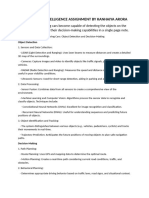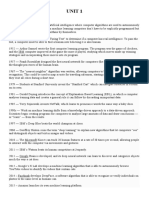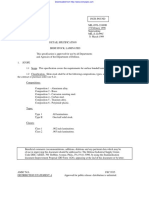0 ratings0% found this document useful (0 votes)
2 viewsIntroduction_to_Machine_Learning
EECS 836: Machine Learning, taught by Professor Zijun Yao, covers course administration, motivation for studying AI/ML, historical milestones, machine learning tasks, neural networks, and optimization techniques. The course includes lectures, assignments, a team project, and emphasizes academic integrity. Key topics include regression, classification, and the use of loss functions and gradient descent in optimizing machine learning models.
Uploaded by
vinayCopyright
© © All Rights Reserved
Available Formats
Download as DOCX, PDF, TXT or read online on Scribd
0 ratings0% found this document useful (0 votes)
2 viewsIntroduction_to_Machine_Learning
EECS 836: Machine Learning, taught by Professor Zijun Yao, covers course administration, motivation for studying AI/ML, historical milestones, machine learning tasks, neural networks, and optimization techniques. The course includes lectures, assignments, a team project, and emphasizes academic integrity. Key topics include regression, classification, and the use of loss functions and gradient descent in optimizing machine learning models.
Uploaded by
vinayCopyright
© © All Rights Reserved
Available Formats
Download as DOCX, PDF, TXT or read online on Scribd
You are on page 1/ 2
Introduction to Machine Learning - EECS 836
1. Course Overview and Administration
Instructor & Schedule:
The course “EECS 836: Machine Learning” is taught by Professor Zijun Yao. It includes
regular lectures (Monday/Friday) with designated office hours, and all class materials
(slides, assignments, projects) are posted on Canvas.
Course Components:
- Lectures: Attend and actively engage.
- Slides & Readings: Review these materials before class.
- Assignments & Exams: Submit on time.
- Team Project: A group project (3–4 students) where you apply machine learning to a real-
world problem.
Grading Policy:
- Components Include: Attendance, assignments, two exams, and a team project.
- Academic Integrity: Cheating is not allowed and similar answers require explanation.
2. Motivation and Future of AI/ML
Why Study Machine Learning?
- AI is expected to create millions of new jobs while transforming industries (e.g.,
healthcare, finance).
- AI might contribute trillions to global GDP in the future.
Definition of AI and Its Subfields:
- AI: The broad science of making machines that can mimic human thinking and behavior.
- ML: A subset of AI focused on building algorithms that learn from data without being
explicitly programmed.
- Deep Learning: A technique within ML that uses neural networks with many layers for
tasks like image or speech recognition.
3. Historical Perspective and Key Milestones
Early AI (Turing Test, 1950): Introduced the idea of testing a machine’s ability to exhibit
intelligent behavior equivalent to humans.
- 1990s: Development of techniques like SVMs and Bayesian networks.
- 1997: Deep Blue (Chess AI) beats a world champion.
- 2010s: Advances like AlexNet, GANs, AlphaGo, and ChatGPT showcase AI’s rapid progress.
4. Machine Learning Tasks and Data Types
Tasks in ML:
- Regression: Predicting a continuous output (e.g., stock prices). Example formula:
y=b+w*x
- Classification: Assigning an input into predefined classes (e.g., spam filtering).
Data Types and Attributes:
- Nominal: Names or labels.
- Binary: Two possible states (0 or 1).
- Ordinal: Ordered values (e.g., small, medium, large).
- Numeric: Continuous (e.g., speed) or discrete values.
5. Neural Networks and Optimization
Neural Networks Basics:
- Consist of layers of interconnected neurons processing input data.
- Key Components: Weights, biases, and activation functions (e.g., Sigmoid function).
Loss Functions and Error Measurement:
- Mean Squared Error (MSE):
L(b, w) = (1/N) * Σ (y_n - ŷ_n)^2
- Mean Absolute Error (MAE): Uses absolute differences instead.
Optimization and Gradient Descent:
- Gradient Descent Formula:
w_new = w_old - η * (∂L/∂w)
where η is the learning rate and ∂L/∂w is the gradient.
6. Summary: Steps in Machine Learning
Step 1: Problem Formulation - Define the type of function needed for the task (e.g.,
classification, regression).
Step 2: Measuring Error - Use a loss function to quantify model performance.
Step 3: Optimization - Adjust model parameters using techniques like gradient descent to
minimize error.
You might also like
- 9. Introduction to Emerging TechnologiesNo ratings yet9. Introduction to Emerging Technologies43 pages
- Machine Learning Introduction - A Comprehensive GuideNo ratings yetMachine Learning Introduction - A Comprehensive Guide13 pages
- Proposed Course Syllabus: Algorithms For Big DataNo ratings yetProposed Course Syllabus: Algorithms For Big Data7 pages
- Artificial Intelligence Undergraduate CurriulumNo ratings yetArtificial Intelligence Undergraduate Curriulum53 pages
- Introduction to AI and Machine LearningNo ratings yetIntroduction to AI and Machine Learning21 pages
- III-II CSM (Ar 20) DL - Units - 1 & 2 - Question Answers As On 4-3-23No ratings yetIII-II CSM (Ar 20) DL - Units - 1 & 2 - Question Answers As On 4-3-2356 pages
- By: Seema S Shalini H S Shashi Kumar Shilpa K Shirin KathrikiNo ratings yetBy: Seema S Shalini H S Shashi Kumar Shilpa K Shirin Kathriki34 pages
- Introduction To Data Structures: Dept. of Computer Science Faculty of Science and TechnologyNo ratings yetIntroduction To Data Structures: Dept. of Computer Science Faculty of Science and Technology20 pages
- Acp Artificial Intelligence Assignment by Kanhaiya AroraNo ratings yetAcp Artificial Intelligence Assignment by Kanhaiya Arora7 pages
- Resource_20240829074951_Class9-unit-1-ai_Reflection,_Ai_Project_Cycle_And_Ai_Ethics-notes_(1) (2)No ratings yetResource_20240829074951_Class9-unit-1-ai_Reflection,_Ai_Project_Cycle_And_Ai_Ethics-notes_(1) (2)5 pages
- III-II CSM (Ar 20) DL 5 Units Question AnswersNo ratings yetIII-II CSM (Ar 20) DL 5 Units Question Answers108 pages
- Algorithms and Data Structures: An Easy Guide to Programming SkillsFrom EverandAlgorithms and Data Structures: An Easy Guide to Programming SkillsNo ratings yet
- Electrical Vendor Directory Jan 2020 To Jun 20200% (1)Electrical Vendor Directory Jan 2020 To Jun 2020231 pages
- Rcs454: Python Language Programming LAB: Write A Python Program ToNo ratings yetRcs454: Python Language Programming LAB: Write A Python Program To39 pages
- Cleaning Public Areas: by Mumtazul IlyaniNo ratings yetCleaning Public Areas: by Mumtazul Ilyani27 pages
- Real Time Face Parcing Using Enhanced KNN and DLIBNo ratings yetReal Time Face Parcing Using Enhanced KNN and DLIB6 pages
- HTTP Damelin - Intranet.co - Za Intranet Fact Sheets 2011 Fact Sheets Dir Part Time School of Business Management Skills Programmes Skills Programme - Project Scheduling - pdf23 201141642No ratings yetHTTP Damelin - Intranet.co - Za Intranet Fact Sheets 2011 Fact Sheets Dir Part Time School of Business Management Skills Programmes Skills Programme - Project Scheduling - pdf23 2011416422 pages
- Metal Forming Lecture 3 Stress Strain AnalysesNo ratings yetMetal Forming Lecture 3 Stress Strain Analyses30 pages
- Lecture 3 - Pressure of Concrete On FormworkNo ratings yetLecture 3 - Pressure of Concrete On Formwork49 pages
- How To Add, Subtract, Multiply, Divide in ExcelNo ratings yetHow To Add, Subtract, Multiply, Divide in Excel6 pages
- Earth and Life Science SHS 3.2 Four Subsystems of EarthNo ratings yetEarth and Life Science SHS 3.2 Four Subsystems of Earth15 pages
























































































